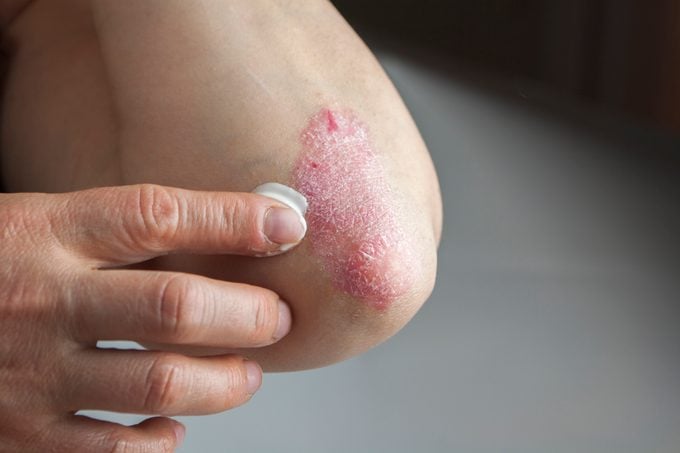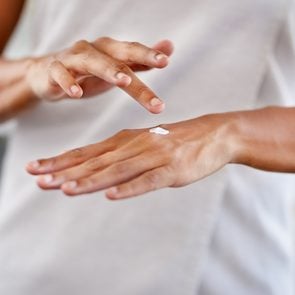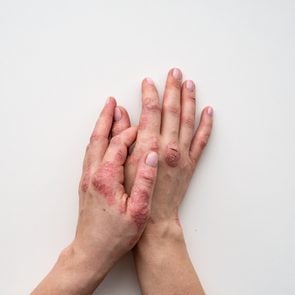Here’s What You Need to Know About Psoriasis Symptoms, Causes, and Treatments
Updated: Jun. 17, 2021
Have scaly, itchy skin? You might have psoriasis. Here are the skin condition's symptoms, causes, types, and treatments.
On This Page
What is psoriasis?
Thick, scaly, itchy skin—this is the hallmark of psoriasis. It’s a skin condition triggered by your immune system.
Your skin cells work overtime, growing so fast that they pile up on top of one another.
When skin cells grow too quickly, it can cause patches of thick, raised skin (called plaques) and scales to appear on the skin.
The thick patches of skin can appear anywhere on your body, but the location depends on the type of psoriasis you have.
Some people report redness, itching, or other health problems.
Psoriasis affects more than 8 million people in the United States, according to the National Psoriasis Foundation.
Psoriasis is chronic, meaning that it’s long-lasting. It can’t be cured, but treatments can relieve symptoms and keep flare-ups from happening.
Here’s a look at common psoriasis symptoms, types, triggers, and treatments.
Symptoms of psoriasis
The most common signs of psoriasis are dry, thick, raised patches of skin and silvery scales that can be very itchy.
You’ll most often find the patches on the elbows, scalp, and knees, but they also can appear on other areas of the body, like the lower back, face, palms, and soles of the feet.
Symptoms might flare for a few days, weeks, or months.
Then they might go away for a while, going into remission.
This cycle can repeat, with triggers like stress and illness causing symptoms to worsen.
Symptoms and locations can depend on the type of psoriasis you have.
Psoriasis causes
Problems with the immune system cause psoriasis.
Signals are somehow crossed, and your immune system triggers your body to overproduce skin cells. They grow way too quickly.
Normally, it takes skin cells about a month to completely grow and then fall off (called shedding), according to the National Psoriasis Foundation. When you have psoriasis, skin cells grow in just three or four days.
Instead of shedding, they pile up on the surface of the skin. This causes plaques, scales, and rough patches of dry skin.
Because it’s an immune disease, psoriasis isn’t contagious.
You can’t catch it from someone else or transmit it to someone who doesn’t have it.

Psoriasis triggers
Psoriasis symptoms come and go.
Different things cause flares, depending on the person.
Once you figure out your triggers, you may be able to limit and avoid some to reduce your risk of flare-ups.
Some common psoriasis triggers include:
Diagnosing psoriasis
When symptoms are mild, you may not even know you have psoriasis. It can be difficult to diagnose because it can look like other skin conditions, such as eczema. (Here’s a guide to psoriasis vs. eczema vs. rosacea.)
A dermatologist is the best doctor to diagnose and treat psoriasis.
Yours will ask you about your symptoms, examine your skin, and may take a small sample of your skin (a biopsy) and examine it under a microscope.
Where psoriasis occurs on the body
Although psoriasis can appear anywhere on the body, there are several common places people with the condition find scaling and itching:
- Scalp psoriasis affects the hairline, forehead, back of the neck, and the skin in and around the ears. More than 60 percent of people who have psoriasis have scalp psoriasis.
- Genital psoriasis can affect the skin in the genital area, as well as the inner and upper thighs. Up to two-thirds of people with psoriasis have genital psoriasis.
- Facial psoriasis can include any area of the face, such as eyes, eyebrows and the upper forehead. It affects about one in three people with psoriasis.
- Nail psoriasis affects about half of people who have psoriasis. Symptoms include white, brown, or yellow nails, denting (pitting) in the nails, and crumbling.
- Hand and foot psoriasis is called palmoplantar psoriasis (PPP). It typically affects the soles of the feet and the palms of the hands and involves dry, thickened skin and painful, deep fissures.
Types of psoriasis
Plaque psoriasis
As many as 80 to 90 percent of the people who have psoriasis have plaque psoriasis.
You can get raised patches of itchy, inflamed skin and scales anywhere on the body, but you’ll often notice them on the scalp, knees, elbows, and lower back.
Depending on your skin type, they might be silvery, white scales, or purple and red.
Guttate psoriasis
Guttate psoriasis is characterized by tiny, round bumps, usually on the arms, legs, and torso. It affects about 8 percent of people who have psoriasis.
Caused by inflammation, the bumps go away on their own—without treatment—after a few weeks or months. Sometimes they never return.
Pustular psoriasis
The main symptom for this type of psoriasis is pus-filled bumps, usually only on the hands and feet. They’re typically painful and are surrounded by inflamed skin.
When the bumps break open and the pus leaks out and dries, the skin to dries and peels.
Inverse psoriasis
This develops on skin folds (places where skin touches), such as the underarms, genitals, under the breasts, and the crease of the buttocks.
Symptoms include smooth patches of red skin that are painful and look raw. About one-quarter of people with psoriasis have this type.
Erythrodermic psoriasis
This rare type affects only 2 percent of people who have psoriasis, but most people who develop it already have another type of psoriasis.
Skin on most of the body looks red and can be shed in long pieces.
Because this condition affects the body’s temperature and fluid balance, symptoms can include fever, chills, a rapid pulse, swelling, and body temperature that goes up and down, particularly on days that are sweltering or freezing.
Other symptoms are pain, severe itching, and muscle weakness.
This type of psoriasis can be life-threatening (and it raises your risk for infection, pneumonia, and heart failure), so it’s important to get medical help immediately.
Psoriatic arthritis
When psoriasis affects your joints, you can develop this chronic disease.
Psoriatic arthritis usually starts about 10 years after psoriasis develops, according to the National Psoriasis Foundation, but sometimes people get this first or develop this without ever having psoriasis.
Symptoms include swollen fingers and toes and stiff painful joints, especially in the morning.
Psoriasis treatments
Although there’s no cure for psoriasis, treatment can help reduce symptoms and clear up your skin.
How you manage your psoriasis depends on what type you have, how severe it is, and what symptoms you have.
Topical treatments
Steroid creams and ointments are the most common treatments for easing itching and inflammation.
They come in different strengths and are sometimes combined with other ingredients, like retinoids.
Nonsteroidal creams or ointments may also be an option, depending on the location, severity, and type of psoriasis you have. They include anthralin, synthetic vitamin D3, and vitamin A.
Not all treatments are available by prescription. You might find shampoos, bath solutions, or bars designed to relieve itching.
Everyone with psoriasis can benefit from a good skin care routine that includes moisturizers to relieve dryness and seal in moisture, suggests the American Academy of Dermatology.
For the best relief, choose a heavy cream or ointment instead of a lotion and opt for a fragrance-free product.
Light therapy
Phototherapy exposes skin to ultraviolet light to ease redness, itching, and flaking.
It’s done under a doctor’s supervision on a regular basis.
It can be used alone or in combination with other treatment, such as medication or topical solutions.
Medication
Doctors often prescribe medication if psoriasis doesn’t respond to topical treatments.
Traditional drugs include acitretin (Soriatane), cyclosporine (Gengraf, Neoral, Sandimmune), and methotrexate (Rheumatrex, Trexall).
Biologics are newer drugs derived from living organisms.
They only target the part of the immune system that is active, so they cause fewer issues with other organs.
Given by shot or intravenous (IV) infusion, biologics are typically prescribed for people with moderate to severe psoriasis, psoriatic arthritis, or both.
Lifestyle changes
Healthy habits and home remedies can also lower your chances of psoriasis flares and keep your symptoms under control. They include:
- Keeping a healthy weight
- Exercising regularly
- Eating a healthy, balanced diet
- Finding ways to reduce stress
- Cutting back on alcohol
- Quitting smoking
Helpful products
- 7 Best Shampoos for Scalp Psoriasis, According to Dermatologists
- 10 Natural Treatments for Psoriasis and Eczema Relief



